Home / Alkyne Hydroboration With “R2BH”
Alkyne Reactions
Alkyne Hydroboration With “R2BH”
Last updated: June 28th, 2025 |
Hydroboration-Oxidation of Alkynes
- As seen in the previous chapter, hydroboration of alkenes with borane (BH3) followed by oxidation (NaOH, H2O2) gives alcohols with anti-Markovnikov regioselectivity (See article: Hydroboration-Oxidation of Alkenes)
- Hydroboration of alkynes is also selective for the anti-Markovnikov product. However, after oxidation with NaOH/H2O2 , we generally do not get the simple addition product (enol). Instead we get aldehydes (with terminal alkynes) or ketones (with internal alkynes). These are constitutional isomers of the expected enol.
- Enols are in equilibrium with their constitutional isomers (aldehydes or ketones), a phenomenon known as keto-enol tautomerism (See article: Keto-Enol Tautomerism). Since C-O pi bonds are stronger than C-C pi bonds, equilibrium generally favors the keto form.
- Although BH3 can be used for the hydroboration of alkynes (and many textbooks / courses teach this) dialkylboranes such as di-siamylborane (“Sia2BH”) or 9-BBN (9-Borabicyclo[3.3.1]nonaneare) are better choices. Dialkylboranes (usually abbreviated R2BH, since they can be considered equivalent for our purposes) generally give higher yields than BH3 in the hydroboration of alkynes.
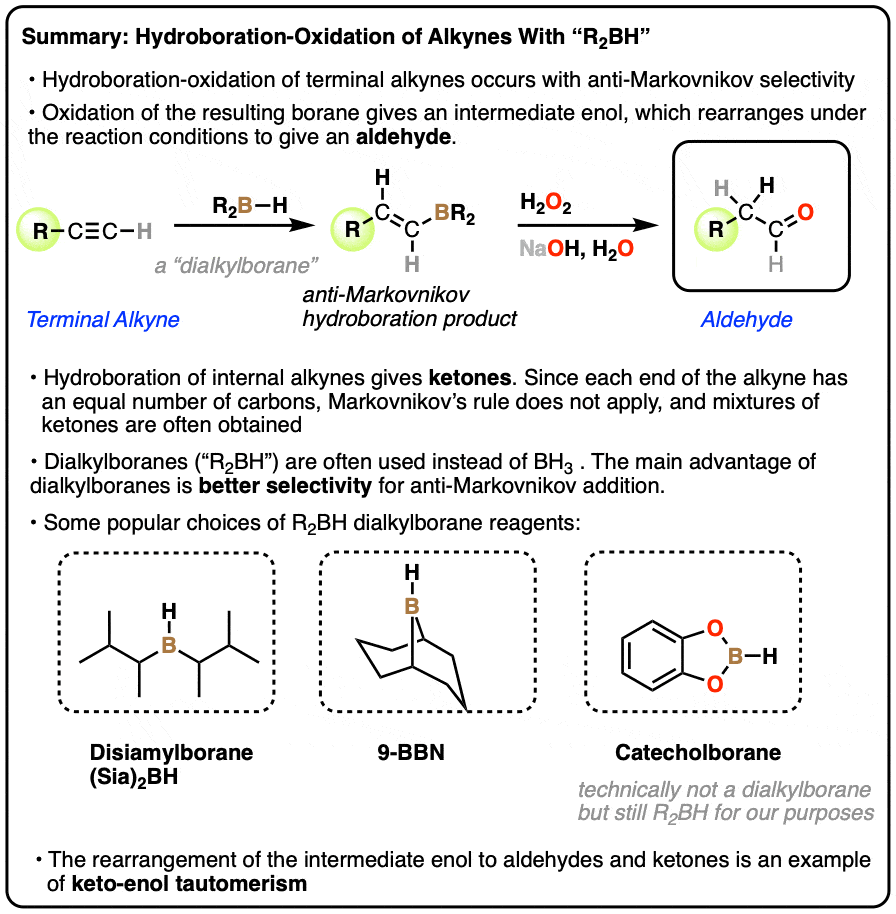
Table of Contents
1. Hydroboration of Alkynes: Not The Products You Expected!
Back in the chapter on alkenes, we learned that alkenes can undergo hydroboration with reagents like borane (BH3) or diborane (B2H6). (See article: Hydroboration-Oxidation of Alkenes). In hydroboration, a C-C pi bond is broken, and a C-H and C-B bond are formed. A notable aspect of the reaction is that the C-B bond tends to form on the least substituted carbon of the alkene. After oxidation of the borane (usually with NaOH/H2O2) we then get an alcohol.
In contrast to acid-catalyzed hydration of alkenes, which forms alcohols on the more substituted carbon of the alkene (“Markovnikov” regioselectivity) [See article – Hydration of Alkenes With Aqueous Acid], hydroboration gives us an alcohol on the least substituted carbon of the alkene (“anti-Markovnikov” regioselectivity). [See article – Hydroboration of Alkenes]
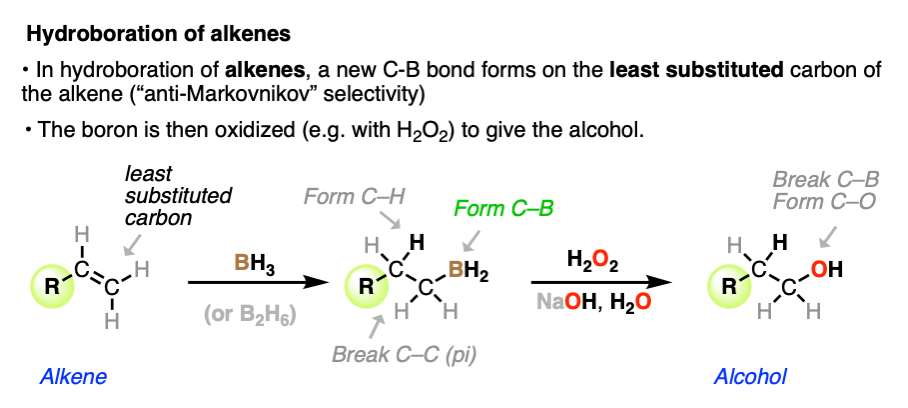
If a reaction works on alkenes, it makes sense to try to apply it to alkynes. After all, there’s only one extra pi bond. What difference could just one extra pi bond make? [Narrator: This is organic chemistry. Of course one extra pi-bond can make a huge difference, mwa-ah-ah (evil laugh)].
If hydroboration follows the same pattern of bonds formed/ broken as that for alkenes, along with anti-Markovnikov selectivity, we should expect to end up with the “alkene-alcohol” (usually referred to as an “enol”) below after oxidation.
When terminal alkynes undergo hydroboration, we don’t get this product. Instead, we get… an aldehyde!
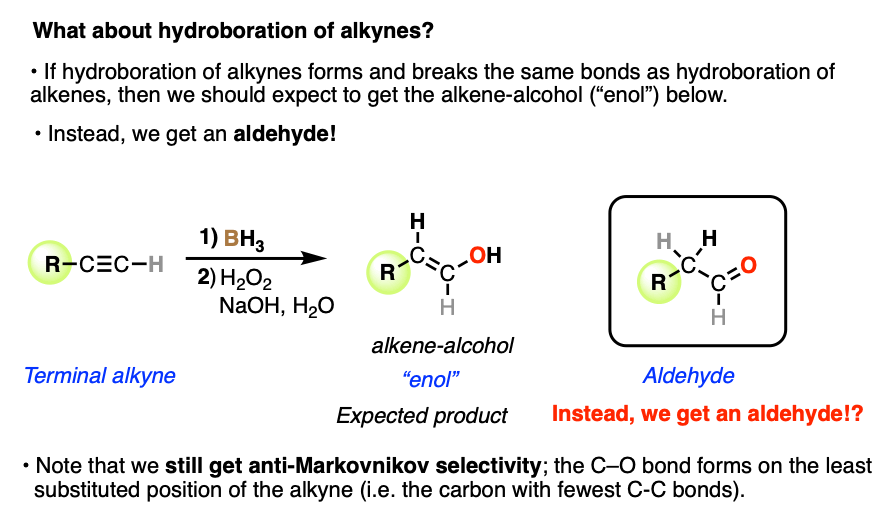
What the…? You might (rightly) be shaking your head or insisting that this is a misprint. Who ordered this?
How did we end up with a C–O pi bond instead of a C–C pi bond?
The only thing that seems consistent here is that the C-O bond forms on the least substituted end of the alkyne (anti-Markovnikov regioselectivity).
Likewise, when internal alkynes undergo hydroboration, the products aren’t enols either. They’re ketones.
(When internal alkynes are attached to groups of similar size, there is no “least substituted” side of the alkyne and therefore no “anti-Markovnikov” selectivity. So we get mixtures of ketones).

So what’s going on here? We expected enols, and end up with aldehydes (or ketones) instead. How?
If you look closely and squint, you may notice that the observed products (aldehydes and ketones) are constitutional isomers of our expected (“enol”) products. (Same molecular formula, different connectivity).
And it turns out that the enols do form, at least as the initial product. But alkenes attached to OH groups (enols) can readily undergo conversion to a constitutional isomer containing a C-O pi bond instead of a C-C pi bond. These constitutional isomers are in equilibrium with each other, and equilibrium tends to favor the form with the C-O (pi) bond. This is known as “keto-enol tautomerism“. [See article: Keto-enol Tautomerism]
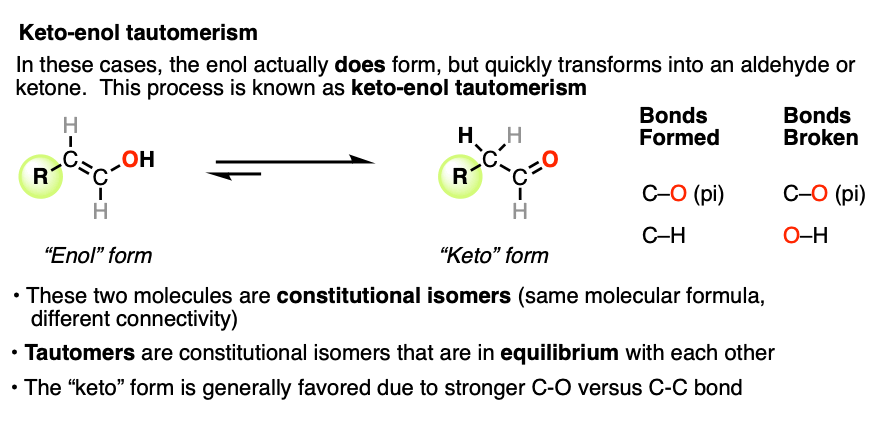
It’s not magic. It’s just that hydroboration-oxidation of alkynes is a gateway to enols, and a fundamental property of enols is that they are in equilibrium with their keto form. We’ll cover this in more detail in Org 2.
(In my opinion, it’s these kinds of unexpected diversions that make organic chemistry is fun! Note: your definition of “fun” may vary).
2. Dialkylboranes (R2BH) Such As Disiamylborane and 9-BBN Are Often Used Instead of BH3 For Hydroboration of Alkynes
Although BH3 can be used for the hydroboration of alkynes, and it often appears in class notes and exams, in practice it’s more common to use dialkylboranes (R2BH) for hydroboration of alkynes. In a dialkylborane, two of the B-H bonds have been replaced by bonds to an alkyl group (R). The remaining B-H is perfectly capable of performing hydroboration reactions. [Note 1]
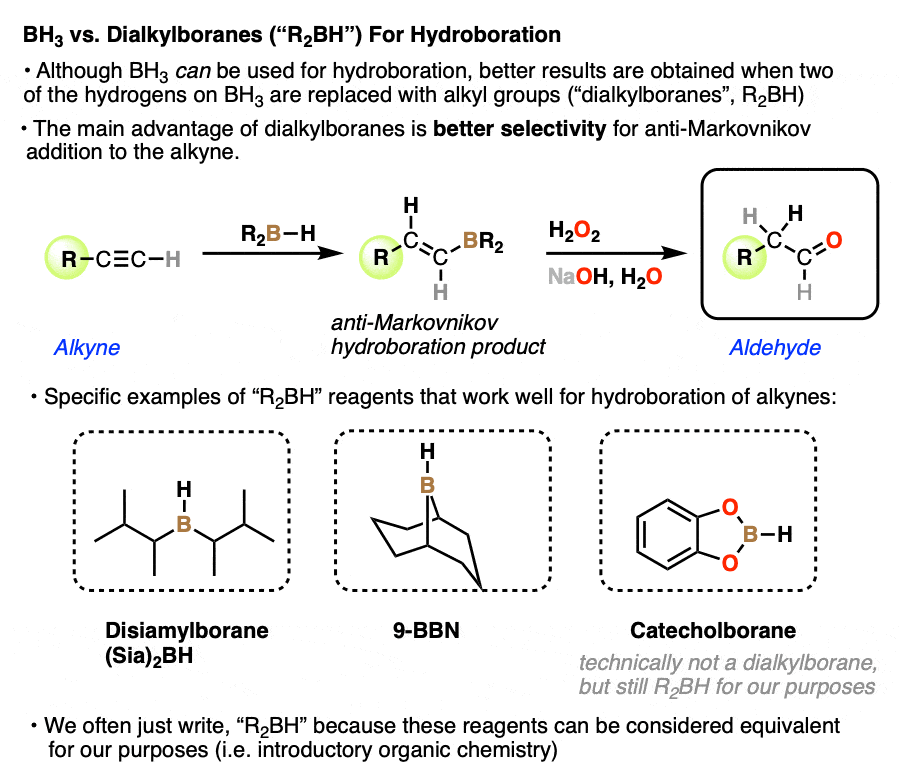
One of the main advantages of using R2BH is that it has better anti-Markovnikov selectivity. The better selectivity arises since the bulky R groups prefer to be close to the alkyne C–H for steric reasons. (If you make a model of what a “Markovnikov-selective” hydroboration would look like with a dialkylborane, you’d find that the alkyl groups on the borane can bump into the alkyl group adjacent to the triple bond).
Three reagents commonly used for hydroboration of alkynes include disiamylborane, 9-BBN (9-Borabicyclo[3.3.1]nonane), and catecholborane.
While these reagents do have their subtle differences, for our purposes these reagents can all considered to be equivalent, and we often just abbreviate them as “R2BH” instead of drawing them out.
Here are some examples of hydroboration of alkynes with disiamylborane and 9-BBN , which we will just abbreviate as “R2BH”):

See if you can draw the product in this case:
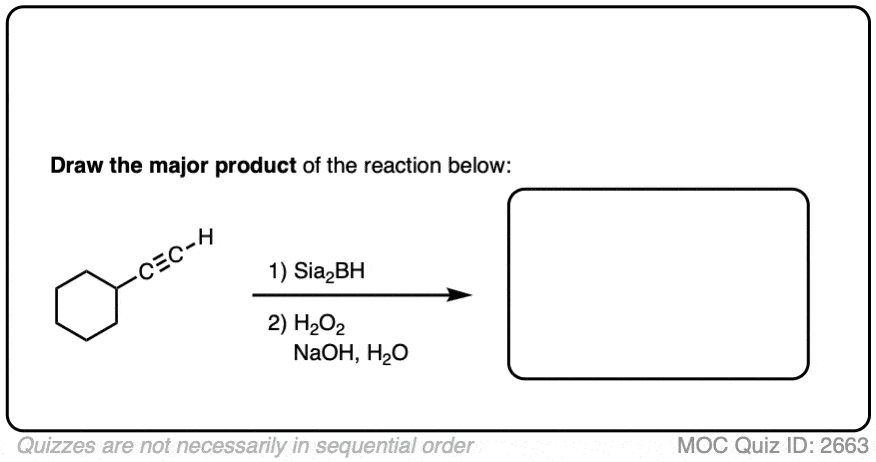 Click to Flip
Click to Flip
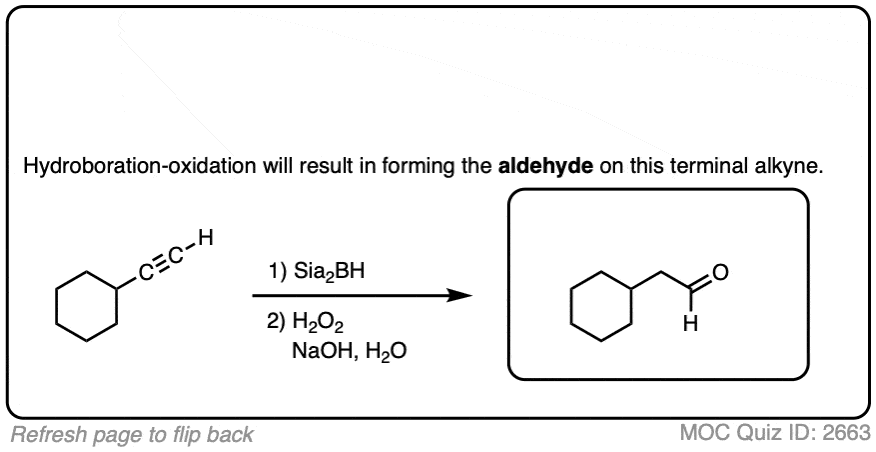
3. Hydroboration of Alkynes: The Mechanism
Let’s take a closer look into the mechanism of the hydroboration of alkynes with R2BH. How does this reaction work?
The mechanism is essentially the same as that in the hydroboration of alkenes, except that we have to draw a mechanism for keto-enol tautomerism of the resulting enol.
In the first step, a concerted hydroboration reaction happens such that the new C-B bond is formed on the carbon bearing the most hydrogens (i.e. the terminal carbon of the alkyne) and a new C-H bond is formed on the more substituted carbon of the alkyne (Step 1). Both the C-H and C-B bonds are formed on the same side of the alkyne, an example of syn addition.
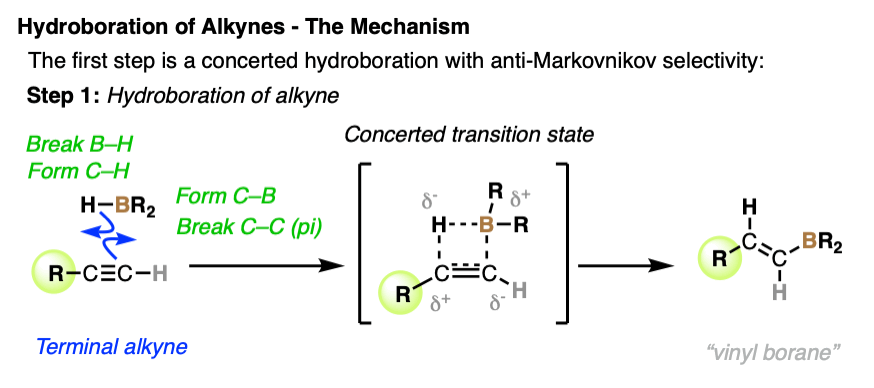
As discussed in the article on hydroboration of alkenes [link], the main reason for anti-Markovnikov selectivity in hydroboration is that the carbon best able to support partial positive charge (the “more substituted” carbon) will be most stabilized when it lines up with the atom bearing a partial negative charge. Since H is more electronegative (2.2) than B (2.0), it’s actually the H that forms a bond to the more substituted carbon, while the partially positive boron forms a bond with the terminal carbon of the alkyne.
Steric effects can also be important, particularly with alkynes. anti-Markovnikov selectivity can be increased by using R2BH instead of BH3. The idea is that the large, bulky alkyl groups will have fewer steric interactions when they are adjacent to the terminal C-H bond on the alkyne.
After hydroboration, the resulting alkenylborane (sometimes, “vinylborane”) is then treated with an oxidant – commonly, hydrogen peroxide (H2O2) in the presence of aqueous base (NaOH/H2O). Base deprotonates hydrogen peroxide, which attacks the boron (Step 2, form B–O).
The oxygen-oxygen bond in peroxides is quite weak (about 40 kcal/mol) . What happens next is that the pair of electrons in the C–B bond act as a nucleophile, attacking oxygen (Step 3, form C–O, break C–B) and breaking the O–O bond. The curved arrow we draw to show electron flow might remind you of the mechanism we see in hydride shifts and alkyl shifts. (See article – Rearrangement Reactions – Hydride Shifts)
Throughout this process, configuration on the alkene is conserved. That is, the C-O bond that is formed here remains on the same side of the alkene as the C–H bond.
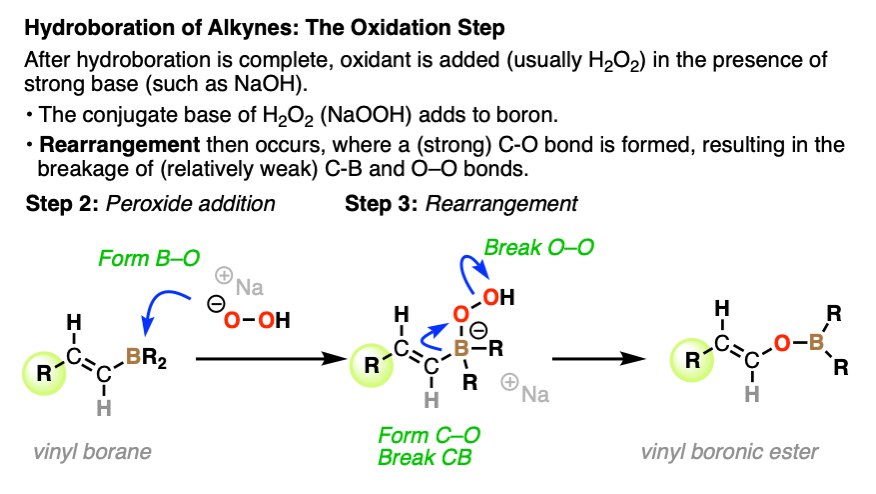
This gives us a molecule where the oxygen remains bonded to boron (a boronic ester). In the presence of aqueous base (NaOH/H2O), the O-B bond is cleaved (Step 4), resulting in a species with a carbon-carbon pi bond attached to a negatively charged oxygen. This is the conjugate base of an enol, and is known as an enolate.
In the presence of water, the enolate undergoes protonation at carbon, (Step 5) resulting in formation of the C-O pi bond and the final aldehyde product. (We’ll have a lot more to say about enols and enolates in Org 2).

4. Summary
Hydroboration of alkynes gives us a new method for the synthesis of aldehydes (with terminal alkynes) and ketones (with internal alkynes).
Previously, we’ve only been able to access aldehydes and ketones through oxidative cleavage of alkenes with ozone (O3) (See article: Ozonolysis of Alkenes)
The reaction to form ketones is generally only useful if we’re starting with a symmetrical ketone. Otherwise, we will often end up with mixtures!
Notes
Related Articles
- Hydroboration Oxidation of Alkenes
- Oxymercuration of Alkynes
- Keto-Enol Tautomerism
- Rearrangement Reactions (1) – Hydride Shifts
- Carbocation Rearrangement Reactions (2) – Alkyl Shifts
- Partial Reduction of Alkynes With Lindlar’s Catalyst
- Partial Reduction of Alkynes With Na/NH3 To Obtain Trans Alkenes
- Acetylides from Alkynes, And Substitution Reactions of Acetylides
- Alkenes To Alkynes Via Halogenation And Elimination Reactions
- Synthesis (5) – Reactions of Alkynes
Note 1. The first attempt to get terminal alkynes to undergo hydroboration resulted in an intractable mess. Details here. It was later found that the main problem is that BH3 does a second hydroboration, and we end up with the diborane, below.
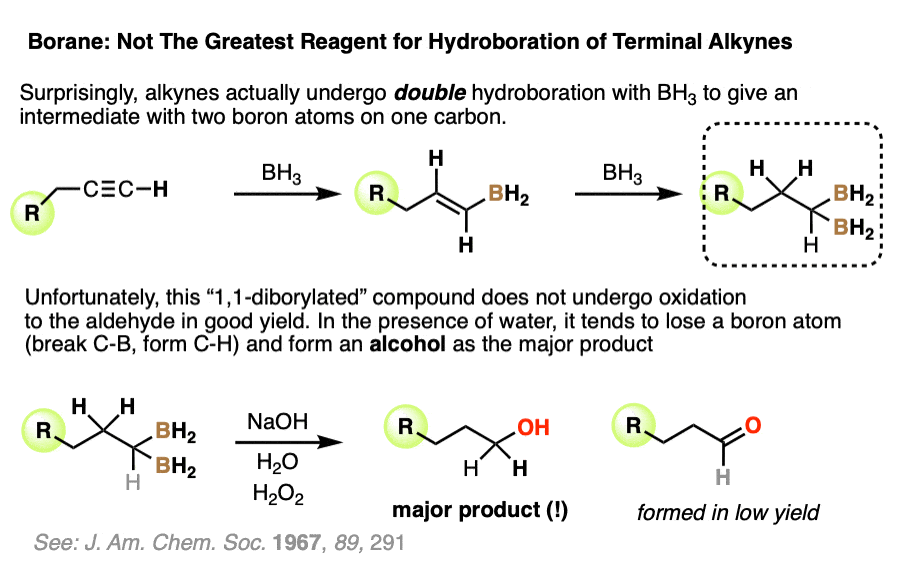
To make a long story short, yields for converting this into aldehydes are not very high. The major product from hydroboration of 1-hexyne was 1-hexanol, which formed when mild acid (water!) was added to the di-borylated product. [see Ref]
A significant amount (10%) of 1,2-hexanediol was also formed, indicating that regioselectivity for the terminal alkyne was not very good (about 9:1 for each hydroboration = about 80% overall).
This was much improved with disiamylborane, which gives good yields of aldehydes and only performs a single hydroboration on the terminal alkyne. [Ref]

Another useful reagent for hydroboration of alkynes is catecholborane. This cleanly gives the vinyl boronic esters, below. [Ref]
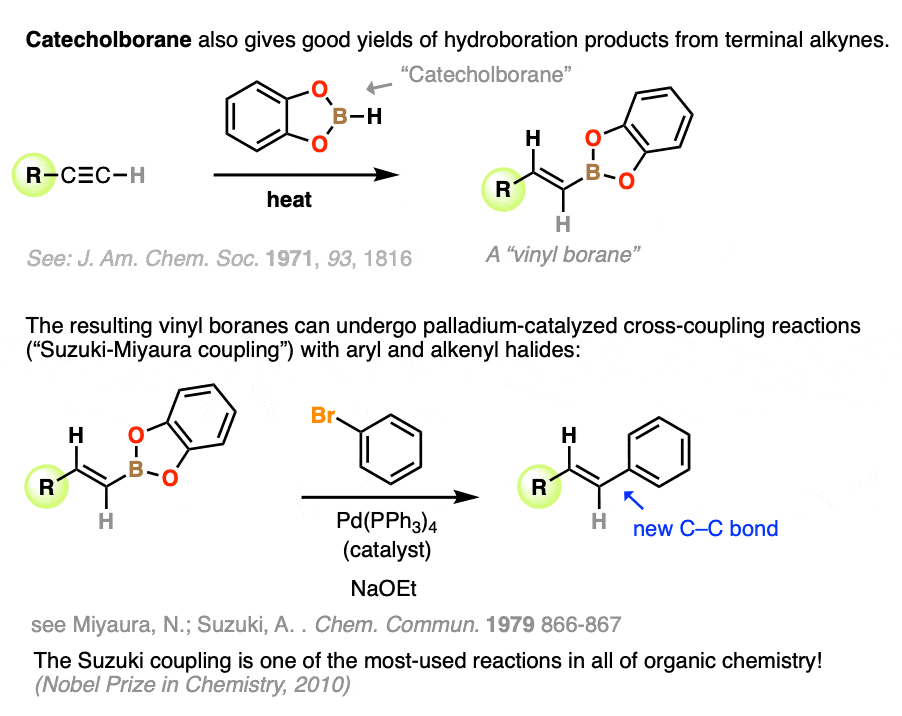
These boronic esters undergo an important reaction with alkenyl halides in the presence of a palladium catalyst known as cross-coupling. The variant with boron has become known as the Suzuki reaction, which has become one of the most commonly used reactions in modern organic chemistry.
So hydroboration of alkynes is important not just for the production of aldehydes from alkynes, also for the formation of alkenyl boronic esters.
Quiz Yourself!

Become a MOC member to see the clickable quiz with answers on the back.

Become a MOC member to see the clickable quiz with answers on the back.
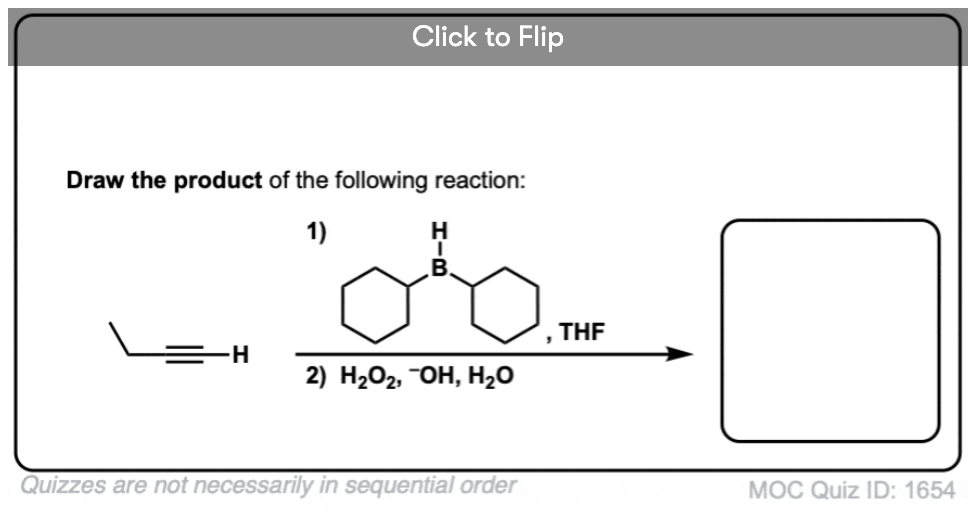
Become a MOC member to see the clickable quiz with answers on the back.
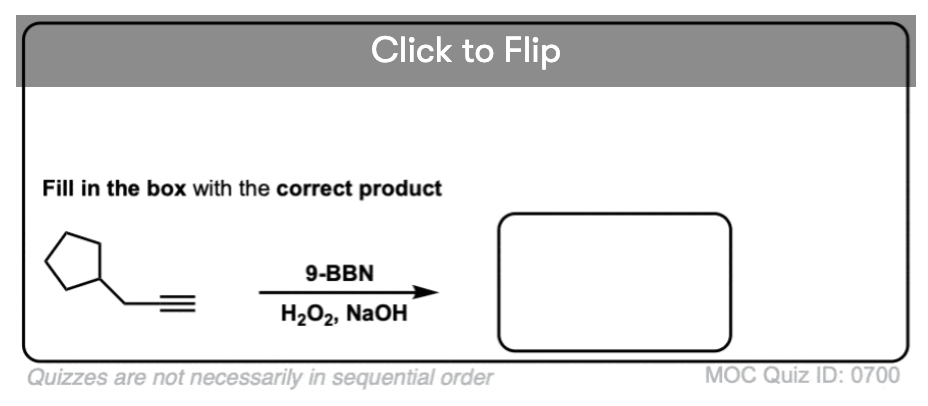
Become a MOC member to see the clickable quiz with answers on the back.

Become a MOC member to see the clickable quiz with answers on the back.

Become a MOC member to see the clickable quiz with answers on the back.
(Advanced) References and Further Reading
Some online books (some available through Archive.org, some not)
- Nobel Lecture. H.C. Brown (1979). [Link] H.C. Brown won the 1979 Nobel Prize (with George Wittig) for the development of boron reagents in organic chemistry.
- Hydroboration. XI. The Hydroboration of Acetylenes—A Convenient Conversion of Internal Acetylenes into cis-Olefins and of Terminal Acetylenes into Aldehydes
Herbert C. Brown and George Zweifel
Journal of the American Chemical Society 1961 83 (18), 3834-3840
DOI: 10.1021/ja01479a024
From the abstract: “The treatment of internal acetylenes, such as 3-hexyne, with the theoretical quantity of hydroborating reagent results in the formation of the corresponding trivinylborane. However, under the same conditions, terminal acetylenes such as 1-hexyne undergo dihydroboration predominantly.” - Germinal Organometallic Compounds. I. The Synthesis and Structure of 1,1-Diborohexane
G. Zweifel and H. Arzoumanian
Journal of the American Chemical Society 1967 89 (2), 291-295
DOI: 10.1021/ja00978a022
From the abstract: “The hydroboration of 1-hexyne with diborane in a 3:1 ratio results in the formation of a polymeric dihydroborated product. Oxidation of this material with alkaline hydrogen peroxide produces 80% 1-hexanol and only 10-12% 1,2-hexanediol. This points to an initial rapid hydrolysis of the dihydroboration intermediate….The use of either [disiamylborane] or dicyclohexylborane as the hydroborating reagents gives the 1,1-diboro- derivatives in 90-96% yield.” - Hydroboration. XXXIX. 1,3,2-Benzodioxaborole (catecholborane) as a new hydroboration reagent for alkenes and alkynes. General synthesis of alkane- and alkeneboronic acids and esters via hydroboration. Directive effects in the hydroboration of alkenes and alkynes with catecholborane
Herbert C. Brown and S. K. Gupta
Journal of the American Chemical Society 1975 97 (18), 5249-5255
DOI: 10.1021/ja00851a038 - A convenient stereoselective synthesis of substituted alkenes via hydroboration-iodination of alkynes
George. Zweifel, Henri. Arzoumanian, and Charles C. Whitney
Journal of the American Chemical Society 1967 89 (14), 3652-3653
DOI: 10.1021/ja00990a061 - Hydroboration. 50. Hydroboration of representative alkynes with 9-borabicyclo[3.3.1]nonane – a simple synthesis of versatile vinyl bora and gem-dibora intermediates
Herbert C. Brown, Charles G. Scouten, and Ronald Liotta
Journal of the American Chemical Society 1979 101 (1), 96-99
DOI: 10.1021/ja00495a016 - PALLADIUM-CATALYZED REACTION OF 1-ALKENYLBORONATES WITH VINYLIC HALIDES: (1Z,3E)-1-PHENYL-1,3-OCTADIENE
Miayura, N.; Suzuki, A.
Org. Synth. 1990, 68, 130
DOI:15227/orgsyn.068.0130
A procedure by Nobel Laureate Akira Suzuki for the hydroboration of an alkyne with catecholborane. The resulting product can then be subsequently used in a Pd-catalyzed Suzuki coupling reaction.
00 General Chemistry Review
01 Bonding, Structure, and Resonance
- How Do We Know Methane (CH4) Is Tetrahedral?
- Hybrid Orbitals and Hybridization
- How To Determine Hybridization: A Shortcut
- Orbital Hybridization And Bond Strengths
- Sigma bonds come in six varieties: Pi bonds come in one
- A Key Skill: How to Calculate Formal Charge
- The Four Intermolecular Forces and How They Affect Boiling Points
- 3 Trends That Affect Boiling Points
- How To Use Electronegativity To Determine Electron Density (and why NOT to trust formal charge)
- Introduction to Resonance
- How To Use Curved Arrows To Interchange Resonance Forms
- Evaluating Resonance Forms (1) - The Rule of Least Charges
- How To Find The Best Resonance Structure By Applying Electronegativity
- Evaluating Resonance Structures With Negative Charges
- Evaluating Resonance Structures With Positive Charge
- Exploring Resonance: Pi-Donation
- Exploring Resonance: Pi-acceptors
- In Summary: Evaluating Resonance Structures
- Drawing Resonance Structures: 3 Common Mistakes To Avoid
- How to apply electronegativity and resonance to understand reactivity
- Bond Hybridization Practice
- Structure and Bonding Practice Quizzes
- Resonance Structures Practice
02 Acid Base Reactions
- Introduction to Acid-Base Reactions
- Acid Base Reactions In Organic Chemistry
- The Stronger The Acid, The Weaker The Conjugate Base
- Walkthrough of Acid-Base Reactions (3) - Acidity Trends
- Five Key Factors That Influence Acidity
- Acid-Base Reactions: Introducing Ka and pKa
- How to Use a pKa Table
- The pKa Table Is Your Friend
- A Handy Rule of Thumb for Acid-Base Reactions
- Acid Base Reactions Are Fast
- pKa Values Span 60 Orders Of Magnitude
- How Protonation and Deprotonation Affect Reactivity
- Acid Base Practice Problems
03 Alkanes and Nomenclature
- Meet the (Most Important) Functional Groups
- Condensed Formulas: Deciphering What the Brackets Mean
- Hidden Hydrogens, Hidden Lone Pairs, Hidden Counterions
- Don't Be Futyl, Learn The Butyls
- Primary, Secondary, Tertiary, Quaternary In Organic Chemistry
- Branching, and Its Affect On Melting and Boiling Points
- The Many, Many Ways of Drawing Butane
- Wedge And Dash Convention For Tetrahedral Carbon
- Common Mistakes in Organic Chemistry: Pentavalent Carbon
- Table of Functional Group Priorities for Nomenclature
- Summary Sheet - Alkane Nomenclature
- Organic Chemistry IUPAC Nomenclature Demystified With A Simple Puzzle Piece Approach
- Boiling Point Quizzes
- Organic Chemistry Nomenclature Quizzes
04 Conformations and Cycloalkanes
- Staggered vs Eclipsed Conformations of Ethane
- Conformational Isomers of Propane
- Newman Projection of Butane (and Gauche Conformation)
- Introduction to Cycloalkanes
- Geometric Isomers In Small Rings: Cis And Trans Cycloalkanes
- Calculation of Ring Strain In Cycloalkanes
- Cycloalkanes - Ring Strain In Cyclopropane And Cyclobutane
- Cyclohexane Conformations
- Cyclohexane Chair Conformation: An Aerial Tour
- How To Draw The Cyclohexane Chair Conformation
- The Cyclohexane Chair Flip
- The Cyclohexane Chair Flip - Energy Diagram
- Substituted Cyclohexanes - Axial vs Equatorial
- Ranking The Bulkiness Of Substituents On Cyclohexanes: "A-Values"
- Cyclohexane Chair Conformation Stability: Which One Is Lower Energy?
- Fused Rings - Cis-Decalin and Trans-Decalin
- Naming Bicyclic Compounds - Fused, Bridged, and Spiro
- Bredt's Rule (And Summary of Cycloalkanes)
- Newman Projection Practice
- Cycloalkanes Practice Problems
05 A Primer On Organic Reactions
- The Most Important Question To Ask When Learning a New Reaction
- Curved Arrows (for reactions)
- Nucleophiles and Electrophiles
- The Three Classes of Nucleophiles
- Nucleophilicity vs. Basicity
- What Makes A Good Nucleophile?
- What Makes A Good Leaving Group?
- 3 Factors That Stabilize Carbocations
- Equilibrium and Energy Relationships
- 7 Factors that stabilize negative charge in organic chemistry
- 7 Factors That Stabilize Positive Charge in Organic Chemistry
- What's a Transition State?
- Hammond's Postulate
- Learning Organic Chemistry Reactions: A Checklist (PDF)
- Introduction to Oxidative Cleavage Reactions
06 Free Radical Reactions
- Free Radical Reactions
- 3 Factors That Stabilize Free Radicals
- Bond Strengths And Radical Stability
- Free Radical Initiation: Why Is "Light" Or "Heat" Required?
- Initiation, Propagation, Termination
- Monochlorination Products Of Propane, Pentane, And Other Alkanes
- Selectivity In Free Radical Reactions
- Selectivity in Free Radical Reactions: Bromination vs. Chlorination
- Halogenation At Tiffany's
- Allylic Bromination
- Bonus Topic: Allylic Rearrangements
- In Summary: Free Radicals
- Synthesis (2) - Reactions of Alkanes
- Free Radicals Practice Quizzes
07 Stereochemistry and Chirality
- Types of Isomers: Constitutional Isomers, Stereoisomers, Enantiomers, and Diastereomers
- How To Draw The Enantiomer Of A Chiral Molecule
- How To Draw A Bond Rotation
- Introduction to Assigning (R) and (S): The Cahn-Ingold-Prelog Rules
- Assigning Cahn-Ingold-Prelog (CIP) Priorities (2) - The Method of Dots
- Enantiomers vs Diastereomers vs The Same? Two Methods For Solving Problems
- Assigning R/S To Newman Projections (And Converting Newman To Line Diagrams)
- How To Determine R and S Configurations On A Fischer Projection
- The Meso Trap
- Optical Rotation, Optical Activity, and Specific Rotation
- Optical Purity and Enantiomeric Excess
- What's a Racemic Mixture?
- Chiral Allenes And Chiral Axes
- Stereochemistry Practice Problems and Quizzes
08 Substitution Reactions
- Nucleophilic Substitution Reactions - Introduction
- Two Types of Nucleophilic Substitution Reactions
- The SN2 Mechanism
- Why the SN2 Reaction Is Powerful
- The SN1 Mechanism
- The Conjugate Acid Is A Better Leaving Group
- Comparing the SN1 and SN2 Reactions
- Polar Protic? Polar Aprotic? Nonpolar? All About Solvents
- Steric Hindrance is Like a Fat Goalie
- Common Blind Spot: Intramolecular Reactions
- Substitution Practice - SN1
- Substitution Practice - SN2
09 Elimination Reactions
- Elimination Reactions (1): Introduction And The Key Pattern
- Elimination Reactions (2): The Zaitsev Rule
- Elimination Reactions Are Favored By Heat
- Two Elimination Reaction Patterns
- The E1 Reaction
- The E2 Mechanism
- E1 vs E2: Comparing the E1 and E2 Reactions
- Antiperiplanar Relationships: The E2 Reaction and Cyclohexane Rings
- Bulky Bases in Elimination Reactions
- Comparing the E1 vs SN1 Reactions
- Elimination (E1) Reactions With Rearrangements
- E1cB - Elimination (Unimolecular) Conjugate Base
- Elimination (E1) Practice Problems And Solutions
- Elimination (E2) Practice Problems and Solutions
10 Rearrangements
11 SN1/SN2/E1/E2 Decision
- Identifying Where Substitution and Elimination Reactions Happen
- Deciding SN1/SN2/E1/E2 (1) - The Substrate
- Deciding SN1/SN2/E1/E2 (2) - The Nucleophile/Base
- SN1 vs E1 and SN2 vs E2 : The Temperature
- Deciding SN1/SN2/E1/E2 - The Solvent
- Wrapup: The Key Factors For Determining SN1/SN2/E1/E2
- Alkyl Halide Reaction Map And Summary
- SN1 SN2 E1 E2 Practice Problems
12 Alkene Reactions
- E and Z Notation For Alkenes (+ Cis/Trans)
- Alkene Stability
- Alkene Addition Reactions: "Regioselectivity" and "Stereoselectivity" (Syn/Anti)
- Stereoselective and Stereospecific Reactions
- Hydrohalogenation of Alkenes and Markovnikov's Rule
- Hydration of Alkenes With Aqueous Acid
- Rearrangements in Alkene Addition Reactions
- Halogenation of Alkenes and Halohydrin Formation
- Oxymercuration Demercuration of Alkenes
- Hydroboration Oxidation of Alkenes
- m-CPBA (meta-chloroperoxybenzoic acid)
- OsO4 (Osmium Tetroxide) for Dihydroxylation of Alkenes
- Palladium on Carbon (Pd/C) for Catalytic Hydrogenation of Alkenes
- Cyclopropanation of Alkenes
- A Fourth Alkene Addition Pattern - Free Radical Addition
- Alkene Reactions: Ozonolysis
- Summary: Three Key Families Of Alkene Reaction Mechanisms
- Synthesis (4) - Alkene Reaction Map, Including Alkyl Halide Reactions
- Alkene Reactions Practice Problems
13 Alkyne Reactions
- Acetylides from Alkynes, And Substitution Reactions of Acetylides
- Partial Reduction of Alkynes With Lindlar's Catalyst
- Partial Reduction of Alkynes With Na/NH3 To Obtain Trans Alkenes
- Alkyne Hydroboration With "R2BH"
- Hydration and Oxymercuration of Alkynes
- Hydrohalogenation of Alkynes
- Alkyne Halogenation: Bromination and Chlorination of Alkynes
- Oxidation of Alkynes With O3 and KMnO4
- Alkenes To Alkynes Via Halogenation And Elimination Reactions
- Alkynes Are A Blank Canvas
- Synthesis (5) - Reactions of Alkynes
- Alkyne Reactions Practice Problems With Answers
14 Alcohols, Epoxides and Ethers
- Alcohols - Nomenclature and Properties
- Alcohols Can Act As Acids Or Bases (And Why It Matters)
- Alcohols - Acidity and Basicity
- The Williamson Ether Synthesis
- Ethers From Alkenes, Tertiary Alkyl Halides and Alkoxymercuration
- Alcohols To Ethers via Acid Catalysis
- Cleavage Of Ethers With Acid
- Epoxides - The Outlier Of The Ether Family
- Opening of Epoxides With Acid
- Epoxide Ring Opening With Base
- Making Alkyl Halides From Alcohols
- Tosylates And Mesylates
- PBr3 and SOCl2
- Elimination Reactions of Alcohols
- Elimination of Alcohols To Alkenes With POCl3
- Alcohol Oxidation: "Strong" and "Weak" Oxidants
- Demystifying The Mechanisms of Alcohol Oxidations
- Protecting Groups For Alcohols
- Thiols And Thioethers
- Calculating the oxidation state of a carbon
- Oxidation and Reduction in Organic Chemistry
- Oxidation Ladders
- SOCl2 Mechanism For Alcohols To Alkyl Halides: SN2 versus SNi
- Alcohol Reactions Roadmap (PDF)
- Alcohol Reaction Practice Problems
- Epoxide Reaction Quizzes
- Oxidation and Reduction Practice Quizzes
15 Organometallics
- What's An Organometallic?
- Formation of Grignard and Organolithium Reagents
- Organometallics Are Strong Bases
- Reactions of Grignard Reagents
- Protecting Groups In Grignard Reactions
- Synthesis Problems Involving Grignard Reagents
- Grignard Reactions And Synthesis (2)
- Organocuprates (Gilman Reagents): How They're Made
- Gilman Reagents (Organocuprates): What They're Used For
- The Heck, Suzuki, and Olefin Metathesis Reactions (And Why They Don't Belong In Most Introductory Organic Chemistry Courses)
- Reaction Map: Reactions of Organometallics
- Grignard Practice Problems
16 Spectroscopy
- Degrees of Unsaturation (or IHD, Index of Hydrogen Deficiency)
- Conjugation And Color (+ How Bleach Works)
- Introduction To UV-Vis Spectroscopy
- UV-Vis Spectroscopy: Absorbance of Carbonyls
- UV-Vis Spectroscopy: Practice Questions
- Bond Vibrations, Infrared Spectroscopy, and the "Ball and Spring" Model
- Infrared Spectroscopy: A Quick Primer On Interpreting Spectra
- IR Spectroscopy: 4 Practice Problems
- 1H NMR: How Many Signals?
- Homotopic, Enantiotopic, Diastereotopic
- Diastereotopic Protons in 1H NMR Spectroscopy: Examples
- 13-C NMR - How Many Signals
- Liquid Gold: Pheromones In Doe Urine
- Natural Product Isolation (1) - Extraction
- Natural Product Isolation (2) - Purification Techniques, An Overview
- Structure Determination Case Study: Deer Tarsal Gland Pheromone
17 Dienes and MO Theory
- What To Expect In Organic Chemistry 2
- Are these molecules conjugated?
- Conjugation And Resonance In Organic Chemistry
- Bonding And Antibonding Pi Orbitals
- Molecular Orbitals of The Allyl Cation, Allyl Radical, and Allyl Anion
- Pi Molecular Orbitals of Butadiene
- Reactions of Dienes: 1,2 and 1,4 Addition
- Thermodynamic and Kinetic Products
- More On 1,2 and 1,4 Additions To Dienes
- s-cis and s-trans
- The Diels-Alder Reaction
- Cyclic Dienes and Dienophiles in the Diels-Alder Reaction
- Stereochemistry of the Diels-Alder Reaction
- Exo vs Endo Products In The Diels Alder: How To Tell Them Apart
- HOMO and LUMO In the Diels Alder Reaction
- Why Are Endo vs Exo Products Favored in the Diels-Alder Reaction?
- Diels-Alder Reaction: Kinetic and Thermodynamic Control
- The Retro Diels-Alder Reaction
- The Intramolecular Diels Alder Reaction
- Regiochemistry In The Diels-Alder Reaction
- The Cope and Claisen Rearrangements
- Electrocyclic Reactions
- Electrocyclic Ring Opening And Closure (2) - Six (or Eight) Pi Electrons
- Diels Alder Practice Problems
- Molecular Orbital Theory Practice
18 Aromaticity
- Introduction To Aromaticity
- Rules For Aromaticity
- Huckel's Rule: What Does 4n+2 Mean?
- Aromatic, Non-Aromatic, or Antiaromatic? Some Practice Problems
- Antiaromatic Compounds and Antiaromaticity
- The Pi Molecular Orbitals of Benzene
- The Pi Molecular Orbitals of Cyclobutadiene
- Frost Circles
- Aromaticity Practice Quizzes
19 Reactions of Aromatic Molecules
- Electrophilic Aromatic Substitution: Introduction
- Activating and Deactivating Groups In Electrophilic Aromatic Substitution
- Electrophilic Aromatic Substitution - The Mechanism
- Ortho-, Para- and Meta- Directors in Electrophilic Aromatic Substitution
- Understanding Ortho, Para, and Meta Directors
- Why are halogens ortho- para- directors?
- Disubstituted Benzenes: The Strongest Electron-Donor "Wins"
- Electrophilic Aromatic Substitutions (1) - Halogenation of Benzene
- Electrophilic Aromatic Substitutions (2) - Nitration and Sulfonation
- EAS Reactions (3) - Friedel-Crafts Acylation and Friedel-Crafts Alkylation
- Intramolecular Friedel-Crafts Reactions
- Nucleophilic Aromatic Substitution (NAS)
- Nucleophilic Aromatic Substitution (2) - The Benzyne Mechanism
- Reactions on the "Benzylic" Carbon: Bromination And Oxidation
- The Wolff-Kishner, Clemmensen, And Other Carbonyl Reductions
- More Reactions on the Aromatic Sidechain: Reduction of Nitro Groups and the Baeyer Villiger
- Aromatic Synthesis (1) - "Order Of Operations"
- Synthesis of Benzene Derivatives (2) - Polarity Reversal
- Aromatic Synthesis (3) - Sulfonyl Blocking Groups
- Birch Reduction
- Synthesis (7): Reaction Map of Benzene and Related Aromatic Compounds
- Aromatic Reactions and Synthesis Practice
- Electrophilic Aromatic Substitution Practice Problems
20 Aldehydes and Ketones
- What's The Alpha Carbon In Carbonyl Compounds?
- Nucleophilic Addition To Carbonyls
- Aldehydes and Ketones: 14 Reactions With The Same Mechanism
- Sodium Borohydride (NaBH4) Reduction of Aldehydes and Ketones
- Grignard Reagents For Addition To Aldehydes and Ketones
- Wittig Reaction
- Hydrates, Hemiacetals, and Acetals
- Imines - Properties, Formation, Reactions, and Mechanisms
- All About Enamines
- Breaking Down Carbonyl Reaction Mechanisms: Reactions of Anionic Nucleophiles (Part 2)
- Aldehydes Ketones Reaction Practice
21 Carboxylic Acid Derivatives
- Nucleophilic Acyl Substitution (With Negatively Charged Nucleophiles)
- Addition-Elimination Mechanisms With Neutral Nucleophiles (Including Acid Catalysis)
- Basic Hydrolysis of Esters - Saponification
- Transesterification
- Proton Transfer
- Fischer Esterification - Carboxylic Acid to Ester Under Acidic Conditions
- Lithium Aluminum Hydride (LiAlH4) For Reduction of Carboxylic Acid Derivatives
- LiAlH[Ot-Bu]3 For The Reduction of Acid Halides To Aldehydes
- Di-isobutyl Aluminum Hydride (DIBAL) For The Partial Reduction of Esters and Nitriles
- Amide Hydrolysis
- Thionyl Chloride (SOCl2) And Conversion of Carboxylic Acids to Acid Halides
- Diazomethane (CH2N2)
- Carbonyl Chemistry: Learn Six Mechanisms For the Price Of One
- Making Music With Mechanisms (PADPED)
- Carboxylic Acid Derivatives Practice Questions
22 Enols and Enolates
- Keto-Enol Tautomerism
- Enolates - Formation, Stability, and Simple Reactions
- Kinetic Versus Thermodynamic Enolates
- Aldol Addition and Condensation Reactions
- Reactions of Enols - Acid-Catalyzed Aldol, Halogenation, and Mannich Reactions
- Claisen Condensation and Dieckmann Condensation
- Decarboxylation
- The Malonic Ester and Acetoacetic Ester Synthesis
- The Michael Addition Reaction and Conjugate Addition
- The Robinson Annulation
- Haloform Reaction
- The Hell–Volhard–Zelinsky Reaction
- Enols and Enolates Practice Quizzes
23 Amines
- The Amide Functional Group: Properties, Synthesis, and Nomenclature
- Basicity of Amines And pKaH
- 5 Key Basicity Trends of Amines
- The Mesomeric Effect And Aromatic Amines
- Nucleophilicity of Amines
- Alkylation of Amines (Sucks!)
- Reductive Amination
- The Gabriel Synthesis
- Some Reactions of Azides
- The Hofmann Elimination
- The Hofmann and Curtius Rearrangements
- The Cope Elimination
- Protecting Groups for Amines - Carbamates
- The Strecker Synthesis of Amino Acids
- Introduction to Peptide Synthesis
- Reactions of Diazonium Salts: Sandmeyer and Related Reactions
- Amine Practice Questions
24 Carbohydrates
- D and L Notation For Sugars
- Pyranoses and Furanoses: Ring-Chain Tautomerism In Sugars
- What is Mutarotation?
- Reducing Sugars
- The Big Damn Post Of Carbohydrate-Related Chemistry Definitions
- The Haworth Projection
- Converting a Fischer Projection To A Haworth (And Vice Versa)
- Reactions of Sugars: Glycosylation and Protection
- The Ruff Degradation and Kiliani-Fischer Synthesis
- Isoelectric Points of Amino Acids (and How To Calculate Them)
- Carbohydrates Practice
- Amino Acid Quizzes
25 Fun and Miscellaneous
- A Gallery of Some Interesting Molecules From Nature
- Screw Organic Chemistry, I'm Just Going To Write About Cats
- On Cats, Part 1: Conformations and Configurations
- On Cats, Part 2: Cat Line Diagrams
- On Cats, Part 4: Enantiocats
- On Cats, Part 6: Stereocenters
- Organic Chemistry Is Shit
- The Organic Chemistry Behind "The Pill"
- Maybe they should call them, "Formal Wins" ?
- Why Do Organic Chemists Use Kilocalories?
- The Principle of Least Effort
- Organic Chemistry GIFS - Resonance Forms
- Reproducibility In Organic Chemistry
- What Holds The Nucleus Together?
- How Reactions Are Like Music
- Organic Chemistry and the New MCAT
26 Organic Chemistry Tips and Tricks
- Common Mistakes: Formal Charges Can Mislead
- Partial Charges Give Clues About Electron Flow
- Draw The Ugly Version First
- Organic Chemistry Study Tips: Learn the Trends
- The 8 Types of Arrows In Organic Chemistry, Explained
- Top 10 Skills To Master Before An Organic Chemistry 2 Final
- Common Mistakes with Carbonyls: Carboxylic Acids... Are Acids!
- Planning Organic Synthesis With "Reaction Maps"
- Alkene Addition Pattern #1: The "Carbocation Pathway"
- Alkene Addition Pattern #2: The "Three-Membered Ring" Pathway
- Alkene Addition Pattern #3: The "Concerted" Pathway
- Number Your Carbons!
- The 4 Major Classes of Reactions in Org 1
- How (and why) electrons flow
- Grossman's Rule
- Three Exam Tips
- A 3-Step Method For Thinking Through Synthesis Problems
- Putting It Together
- Putting Diels-Alder Products in Perspective
- The Ups and Downs of Cyclohexanes
- The Most Annoying Exceptions in Org 1 (Part 1)
- The Most Annoying Exceptions in Org 1 (Part 2)
- The Marriage May Be Bad, But the Divorce Still Costs Money
- 9 Nomenclature Conventions To Know
- Nucleophile attacks Electrophile
27 Case Studies of Successful O-Chem Students
- Success Stories: How Corina Got The The "Hard" Professor - And Got An A+ Anyway
- How Helena Aced Organic Chemistry
- From a "Drop" To B+ in Org 2 – How A Hard Working Student Turned It Around
- How Serge Aced Organic Chemistry
- Success Stories: How Zach Aced Organic Chemistry 1
- Success Stories: How Kari Went From C– to B+
- How Esther Bounced Back From a "C" To Get A's In Organic Chemistry 1 And 2
- How Tyrell Got The Highest Grade In Her Organic Chemistry Course
- This Is Why Students Use Flashcards
- Success Stories: How Stu Aced Organic Chemistry
- How John Pulled Up His Organic Chemistry Exam Grades
- Success Stories: How Nathan Aced Organic Chemistry (Without It Taking Over His Life)
- How Chris Aced Org 1 and Org 2
- Interview: How Jay Got an A+ In Organic Chemistry
- How to Do Well in Organic Chemistry: One Student's Advice
- "America's Top TA" Shares His Secrets For Teaching O-Chem
- "Organic Chemistry Is Like..." - A Few Metaphors
- How To Do Well In Organic Chemistry: Advice From A Tutor
- Guest post: "I went from being afraid of tests to actually looking forward to them".
Hello Sir, this place is the best destination for organic chemistry enthusiasts. I have really benefitted from the comprehensive presentations and lucid way of explanations. Thank you so much. A small request,can you name any similar resource for inorganic chemistry?
Not that I know of.